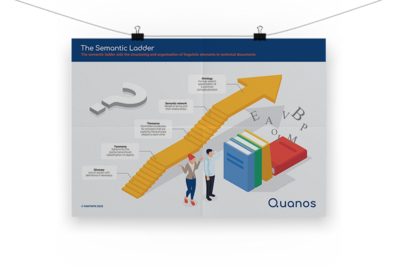Semantics in Technical Documentation
Semantics is a buzz word that continues to circulate the technology world. “Semantic web” or “semantic knowledge management” are terms that are discussed intensively. But what is meant by “semantics” and what role does it play in technical writing?

The semantics of semantics
Semantics is the study of meaning. It examines how we understand words and the relationships that exist between the meanings of different words.
But why is semantics a topic in technology? First, because it improves access to information. Without semantics, you’d have a hard time finding relevant content via the search function because it would only search for exact matches rather than by meaning. Only semantics makes content intuitively accessible. Semantics also helps to make content more machine readable and manageable.
On the other hand, semantics is also a perennial issue in IT because the meaning is not as simple as you might think at first. For example, the meaning of words changes depending on the context in which they are used. “Seal” will be understood differently in a zoo brochure than in an installation manual for a machine. Conversely, the same meaning is often expressed by several words. An “instruction manual” is also called a “user guide”, or an “automobile” a “car”.
Semantics in technical writing
Technical writers are familiar with these problems, which is why many of them have been dealing with terminology for a long time. Terminology clearly specifies what a term means and which words are used to refer to the object for which the term stands.
Up to now there have been two reasons for terminology work in technical writing:
- The means of expression in texts should be specific and precise so that they cannot lead to misunderstandings.
- Well-maintained terminology should contribute to being able to quickly and easily produce translations.
For some time now, however, another aspect has been added to terminology work and the associated meaning definitions. This is because smart information and the trend towards digitalization demand more semantics in the content pools. The information can only be addressed and used in different contexts through explicit and very specific semantics. In order to achieve this, slightly more sophisticated organization principles than in conventional terminology work are needed.
The semantic ladder
Terms and meanings can be organized according to different principles. These principles are often represented as the “semantic ladder”. The higher the organization principle is on the ladder, the more semantics the model also contains (and the more effort that must be put into the creation).
Glossary
On the bottom step is the organization of meanings in a glossary. This is a simple list of words and their explanations. Glossaries are already used in many companies today.
Taxonomy
One step higher are the taxonomies. Here, the words are not only listed but they are placed in an – unspecified – hierarchical structure. Taxonomies are often used in content management.
Thesaurus
A thesaurus, in turn, is a controlled vocabulary for concepts that are placed in a hierarchical relationship with one another as a broader term and narrower term.
Semantic network
Semantic networks mark additional concept relations beyond purely hierarchical relations. For example, these can be relationships such as “opposite”, “X contains Y”, or even “X is suitable for Y”.
Ontology
Finally, on the top step are ontologies. They are explicit, formal specifications of a common conceptualization. Ideally, ontologies can therefore cover all semantic relationships of a topic.
Poster: The Semantic Ladder
Using semantics
Of course, establishing a semantic model should not and cannot be an end in itself. In fact, the models offer a host of useful applications.
The basic use is of course, as before, in terminology. However, information models can also be created to reinforce the content strategy of the technical writing department. Semantics is also useful for metadata models and metadata mapping.
When switching to a new content management system, legacy data transfer is an important factor. Here, existing content can be automatically classified by suitable semantics. Once the content is tagged with additional metadata, it can also be made available easily and flexibly. Whether for a service app, expert system, chatbot, or a complete content delivery solution, semantics allows the content to be delivered conveniently and automatically.
However, the most powerful use of semantics is in company-wide use, when companies rely on Industry 4.0. Here, it is the basis for condition monitoring and predictive maintenance, and therefore provides the content framework for the much discussed digital information twin.
It’s clear to see that semantics is at the heart of modern technical communication. It paves the way for flexible information provision and the integration of content into machines and processes. That’s why it’s worthwhile for technical writers to engage with semantic models.



